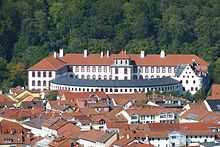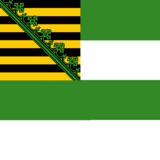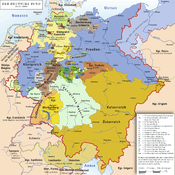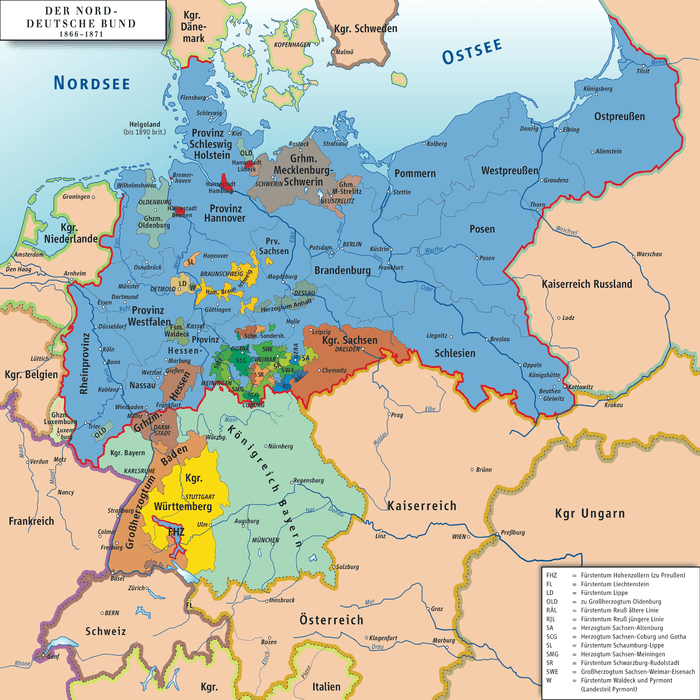Duchy of Saxe-Meiningen
| Duchy of Saxe-Meiningen Herzogtum Sachsen-Meiningen | ||||||
| State of the Holy Roman Empire, State of the Confederation of the Rhine, State of the German Confederation, State of the North German Confederation, State of the German Empire | ||||||
| ||||||
| ||||||
| Anthem Vaterlandsgesang der Sachsen-Meininger | ||||||
 Saxe-Meiningen within the German Empire | ||||||
| Capital | Meiningen | |||||
| Government | Principality | |||||
| Duke of Saxe-Meiningen | ||||||
| - | 1675–1706 | Bernhard I | ||||
| - | 1914–18 | Bernhard III | ||||
| Historical era | Early modern period | |||||
| - | Partitioned from Saxe-Gotha |
1680 | ||||
| - | Acquired Saxe-Hildburghausen |
1826 | ||||
| - | Duchy abolished | 1918 | ||||
| - | Merged into Thuringia | 1920 | ||||
| Area | ||||||
| - | 1905 | 2,468 km² (953 sq mi) | ||||
| Population | ||||||
| - | 1905 est. | 269,000 | ||||
| Density | 109 /km² (282.3 /sq mi) | |||||
The Duchy of Saxe-Meiningen (/ˈsæks ˈmaɪnɪŋən/; German pronunciation: [ˈzaksə ˈmaɪnɪŋən]) was one of the Saxon duchies held by the Ernestine line of the Wettin dynasty, located in the southwest of the present-day German state of Thuringia.
Established in 1681,[1] by partition of the Ernestine duchy of Saxe-Gotha among the seven sons of deceased Duke Ernest the Pious, the Saxe-Meiningen line of the House of Wettin lasted, without much distinction, until the end of the German monarchies in 1918.
History


In the 1680 partition, the former Franconian lands of the extinct House of Henneberg fell to Ernest's third son, Bernhard, who chose the town of Meiningen as his residence and became the first Duke of Saxe-Meiningen. From 1682 Duke Bernhard I had the Schloss Elisabethenburg built and in 1690 established a court orchestra (Hofkapelle), in which Johann Ludwig Bach later became the Kapellmeister (1711).
In the reshuffle of Ernestine territories that occurred following the extinction of the Saxe-Gotha-Altenburg line upon the death of Duke Frederick IV in 1825, Duke Bernhard II of Saxe-Meiningen received the lands of the former Duchy of Saxe-Hildburghausen as well as the Saalfeld territory of the former Saxe-Coburg-Saalfeld duchy. As Bernhard II had supported Austria in the 1866 Austro-Prussian War, the prime minister of victorious Prussia, Otto von Bismarck, enforced his resignation in favour of his son Georg II, after which Saxe-Meiningen was admitted to join the North German Confederation.
In the German Revolution after World War I, Duke Bernhard III, brother-in-law of Emperor Wilhelm II, was forced to abdicate on 10 November 1918. The succeeding Free State of Saxe-Meiningen was merged into the new state of Thuringia in 1920.
In 1905 the capital Meiningen had an area of 2,468 km² and a population of 269,000. The summer residence was at Altenstein Castle. Since 1868 the duchy comprised the Kreise (districts) of Hildburghausen, Sonneberg and Saalfeld as well as the northern exclaves of Camburg and Kranichfeld.
As of 2012 the head of the Ducal House of Saxe-Meiningen, Prince Frederick Konrad (born 1952), has no children, so the representation of his house will pass to his half brother Friedrich Ernst's (1935-2004) son Prince Constantin (* 1980).
Dukes of Saxe-Meiningen


- Bernhard I (1680–1706)
- Ernst Ludwig I (1706–24), son of Bernhard I
- Ernst Ludwig II (1724–29), son of Ernst Ludwig I
- Karl Frederick (1729–43), son of Ernst Ludwig I
- Frederick Wilhelm (1743–46), son of Bernhard I
- Anton Ulrich (1746–63), son of Bernhard I
- Karl Wilhelm (1763–82), son of Anton Ulrich
- Georg I (1782–1803), son of Anton Ulrich, father of Queen Adelaide
- Bernhard II (1803–66), son of Georg I
- Georg II (1866–1914), son of Bernhard II
- Bernhard III (1914–18), son of Georg II
Dukedom abolished in 1918
Heads of the Ducal House of Saxe-Meiningen, post-monarchy
- Bernhard III (1918–1928)
- Prince Ernst (1928–1941)
- Prince Georg III (1941–1946)
- Prince Bernhard IV (1946–1984)
- Prince Konrad (1984–Present)
References
- ↑
 "Saxe-Meiningen". Catholic Encyclopedia. New York: Robert Appleton Company. 1913.
"Saxe-Meiningen". Catholic Encyclopedia. New York: Robert Appleton Company. 1913.
External links
- "Saxe-Meiningen Family Genealogy". Archived from the original on 2012-06-30.
 Chisholm, Hugh, ed. (1911). "Saxe-Meiningen". Encyclopædia Britannica (11th ed.). Cambridge University Press
Chisholm, Hugh, ed. (1911). "Saxe-Meiningen". Encyclopædia Britannica (11th ed.). Cambridge University Press
| Wikimedia Commons has media related to Duchy of Saxe-Meiningen. |
| |||||||||||||||||||||||
| |||||||
| |||||||||||||||||||||||||||||||||||||||||
| |||||||||||||||||||||||||||||||||||||||||||||
| |||||||||||||||||||
| ||||||||||||||||||||||

.png)





